How to learn tournament Poker Strategy with ICMIZER 3
Contents
- The 2 stepped hand history review process in ICMIZER
- Hand #1: How to play against BB reraise all-in versus our raise from BTN
- Hand #2: How to call against BTN push 3-handed with a short stack
- Hand #3: How to defend versus SB raise 3-handed from the Big Blind position
The 2 stepped hand history review process in ICMIZER
The review process consists of 2 easy steps:
- Set up the hand history. This includes setting up all information that can be typically found in hand history text: stacks, blinds, number of players, their preflop actions, etc. You can set it up manually or load the hand history or an entire tournament from a file. Also on this step, you select the correct tournament and calculation settings like FGS model depth, the number of remaining players in MTT or bounties in Bounty tournaments.
- ICMIZE. Once you are done with step one simply press the ICMIZE button and ICMIZER will do its work. It will calculate the optimal preflop strategy for all players as a Nash equilibrium solution using the precise CFR+ algorithm and display the optimal push/fold chart for this tournament situation. It will include the optimal preflop play for each out of 169 potential starting preflop hands.
Also on 2nd step, you can play around with all of the ranges to see how it changes the optimal preflop strategy for any of the players or use additional analysis tools like the Charts functionality.
Note that the first step is easy and very straightforward. Because of this, the first hand history review section covers it in detail. Then when we review the other hand histories we assume that you can complete the first step and focus on the second step and the interpretation of calculated results.
Hand #1: How to play against BB reraise all-in versus our raise from BTN
Classic 9-max Sit'n'Go, 50/30/20 payouts
60/120-15 blinds, 6 players
UTG: 4,075
MP: 1,837
CO: 1,105
Hero (BTN): 3,748
SB: 1,060
BB: 1,675
Preflop: Hero is BTN with KQo
3 folds, Hero raises to 240, SB folds, BB raises to 1,675 and is all-in, Hero ?
First, you need to set up the correct tournament and calculation settings. Click ❶ the Tournament Selector button. The tournament selector pop up will appear. In the Tournament Selector choose ❷ ICM %EV mode and turn on the ❸ FGS checkbox and set its value (depth) to 3 which is recommended for 6 players.
Make sure to choose the right tournament that has the correct payouts, which are used for the calculations and the resulting ranges are fully dependent on them. In our case, it is the ❹ PokerStars SNG 9-max Turbo (tournament specified the payouts and the default blind levels).
In ICM %EV ICMIZE will take into account the payout structure of your tournament and the results will be displayed as the percentage of the total prize pool of the tournament.
Turning the FGS on tells ICMIZER to use the advanced Future Game Simulations model for its calculations. FGS is the most advanced model for poker tournaments, which compared to ICM is the model of the next generation of precision and complexity.
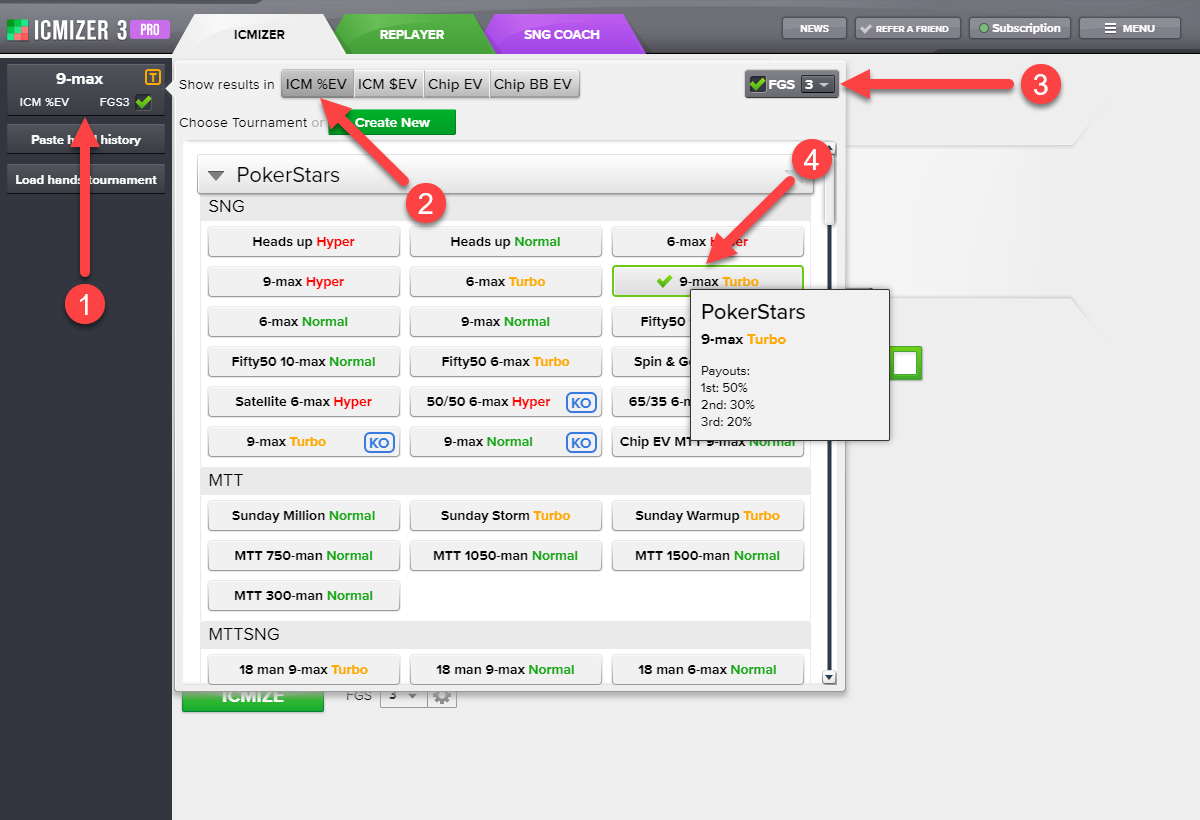
If you can't find your tournament in our predefined list, you will need to create a new tournament by using the green Create New button and the Create Tournament dialog. This is important for most MTTs & live tournaments because we simply cannot have everything available in this list.
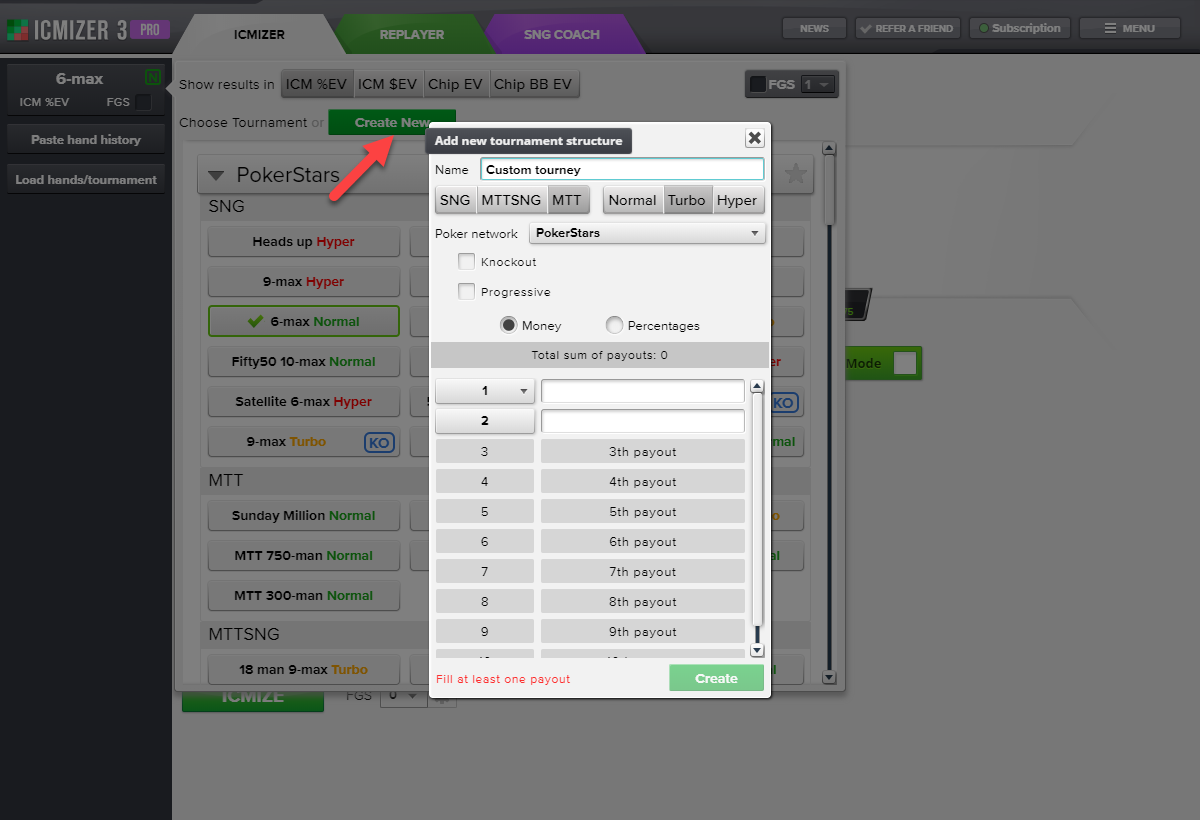
Then click the ❶ the Tournament Selector button again to hide tournament selector menu. It should look like this:
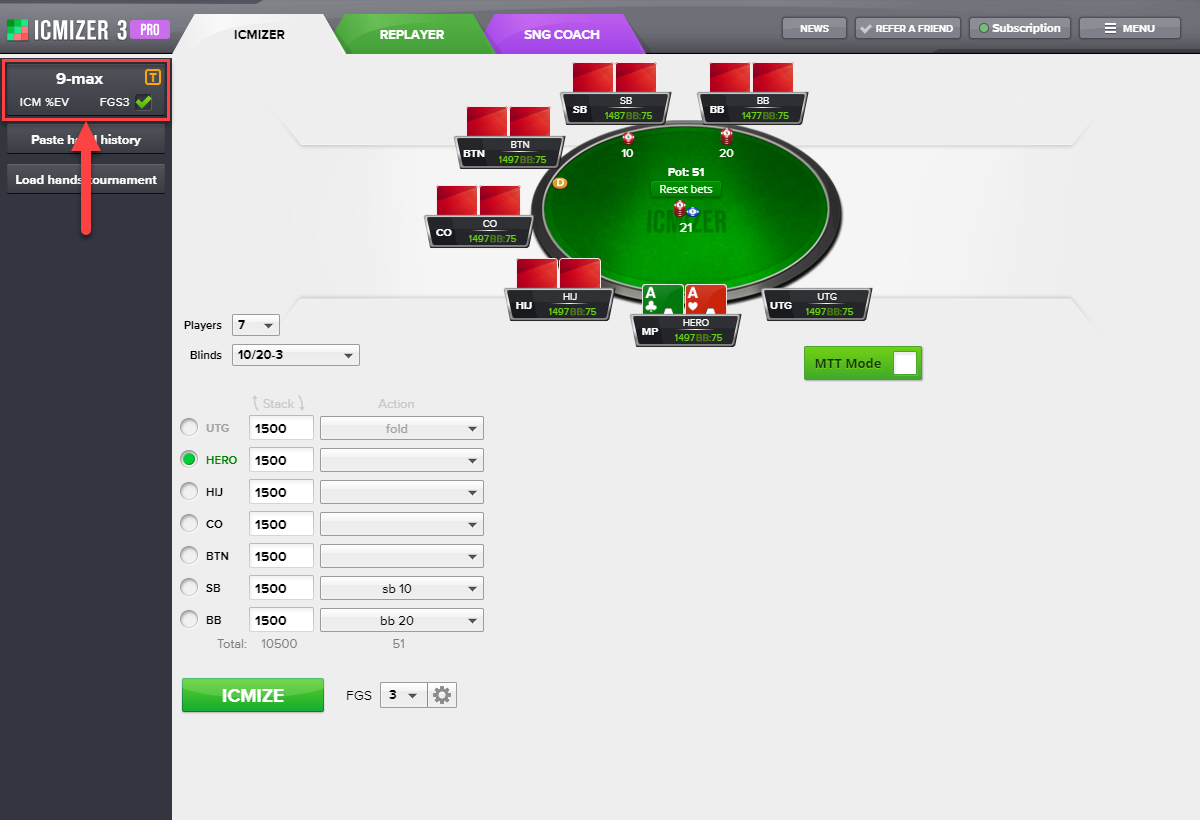
We can see the short version of everything that we have selected in the previous step displayed on the tournament selector button.
Next, set the number of players to 6 from the ❶ players selector drop down menu and the blinds level 60/120-15 from the ❷ blinds selector drop down menu. Note that if you need to add a blind that is not in the list, you can click the green ❸ Create new button and add a custom blind level to any tournament.
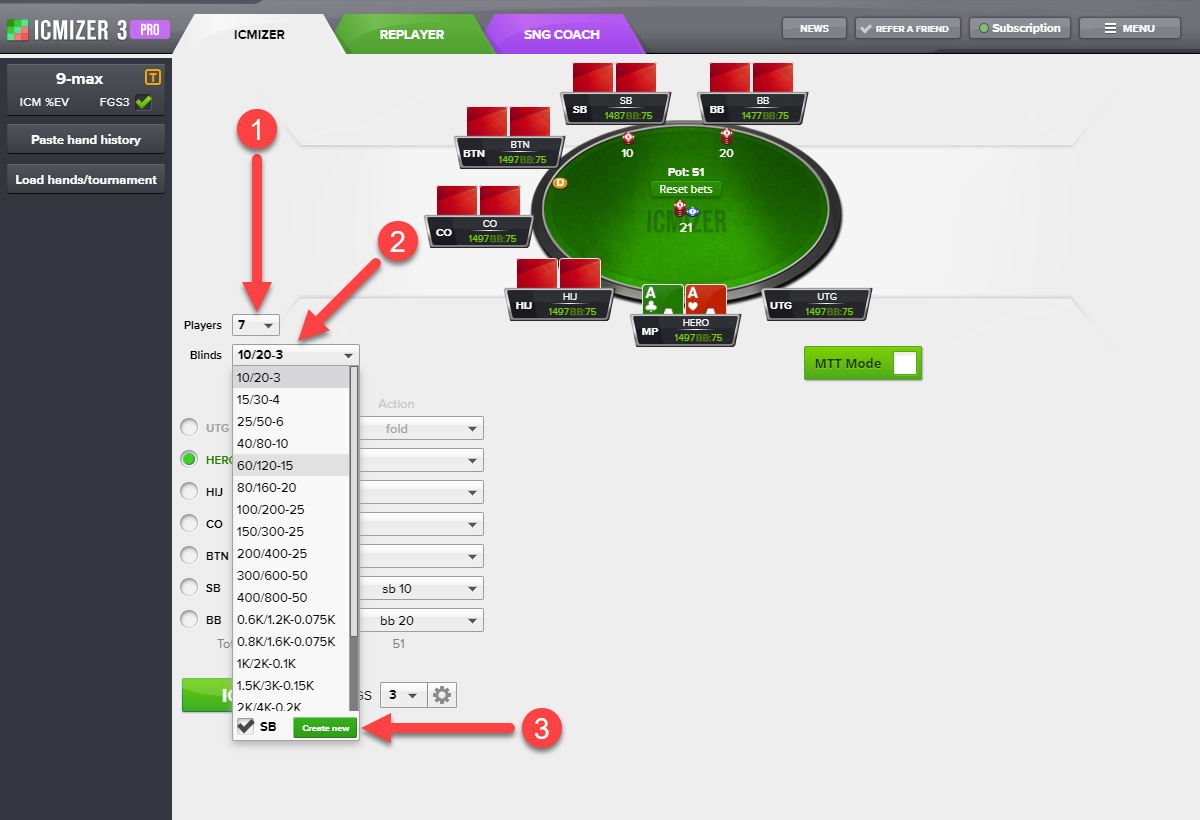
Now set Hero position to BTN by clicking to the corresponding ❶ position radio button and ❷ fill in all the stacks:
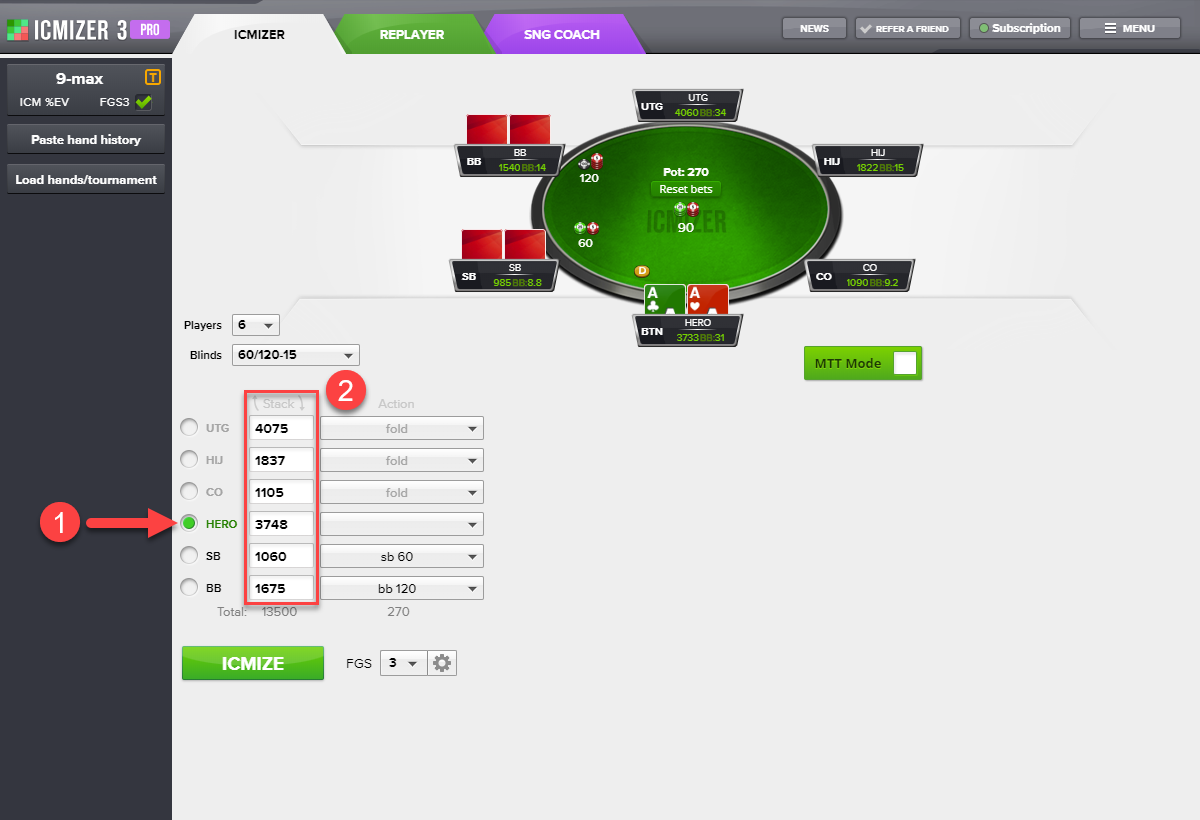
Now we need to set the correct raise size for Hero. For this click the ❶ action editor button next to Hero, set the raise size to 240 by clicking ❷ Raise 240 button.
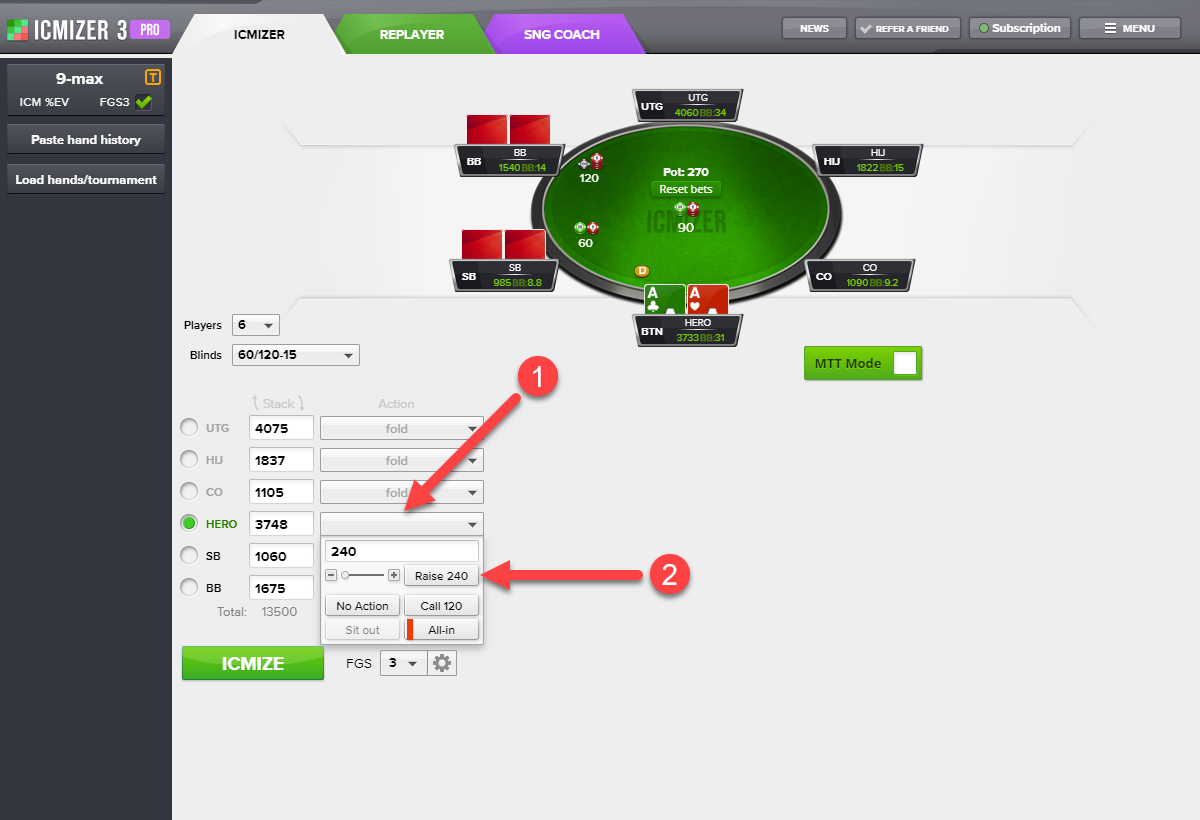
Now edit the action of the player on the BB position. Click the ❶ action editor button next to BB and set action to all-in by clicking ❷ All-in button.
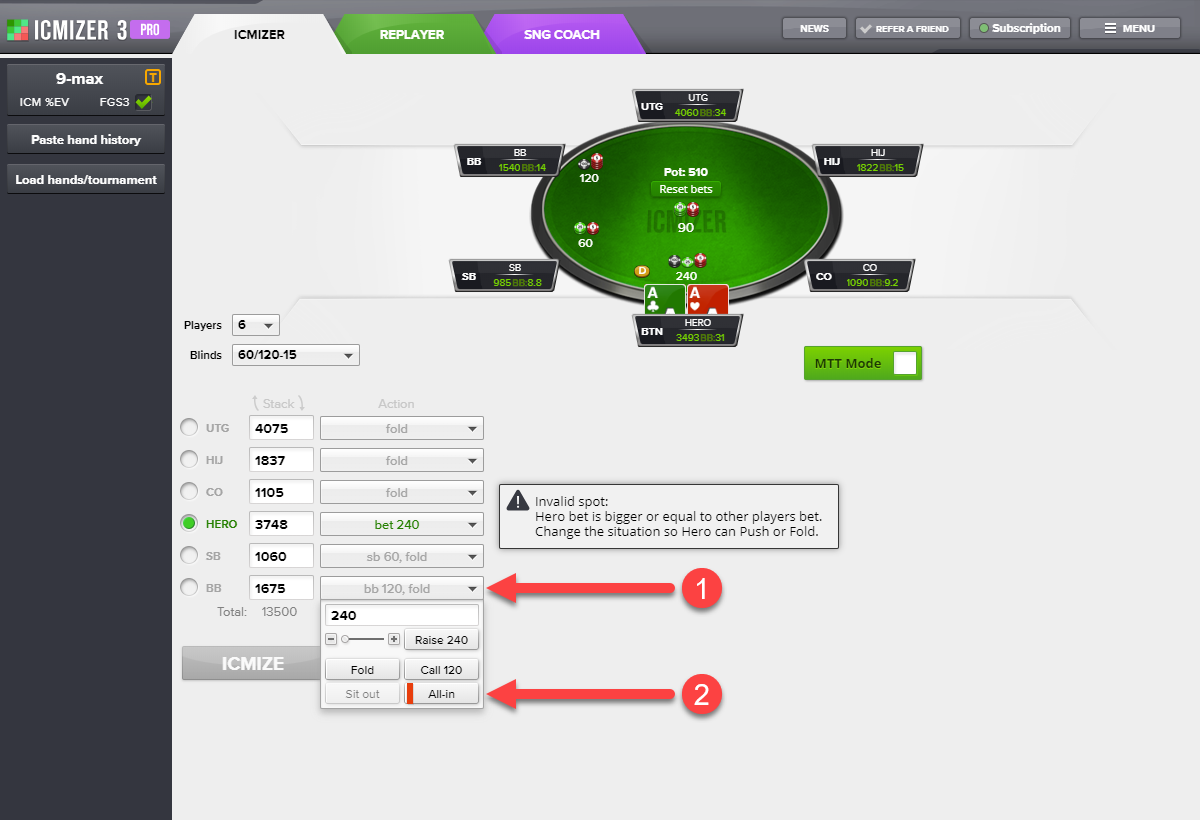
Change Hero hand by clicking his cards and selecting KQo.
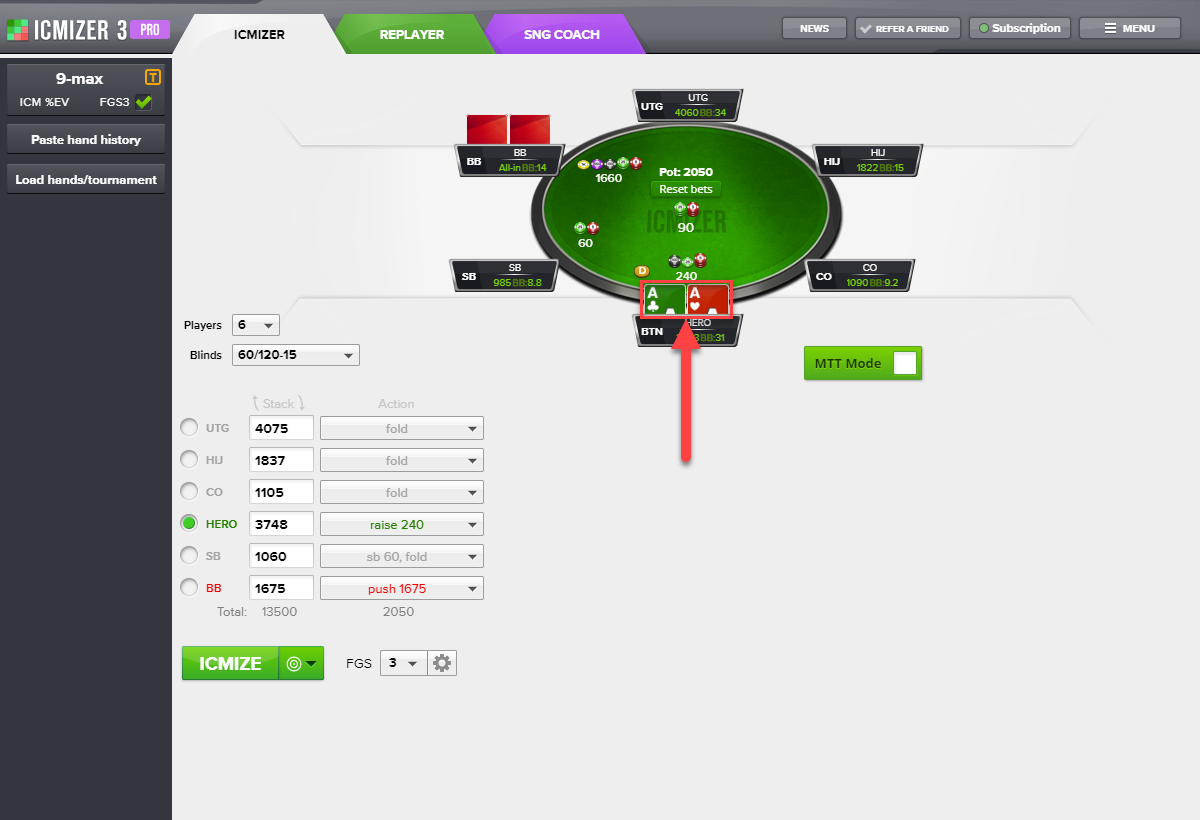
We have now finished setting up the hand. All the settings above except the ones at Tournament Selector can be done automatically by Paste hand history or Load hands/tournament buttons. ICMIZER supports loading hand history from many poker rooms and in various formats.
Now click the ICMIZE button. After processing, you will get the optimal push/fold chart for this tournament situation.
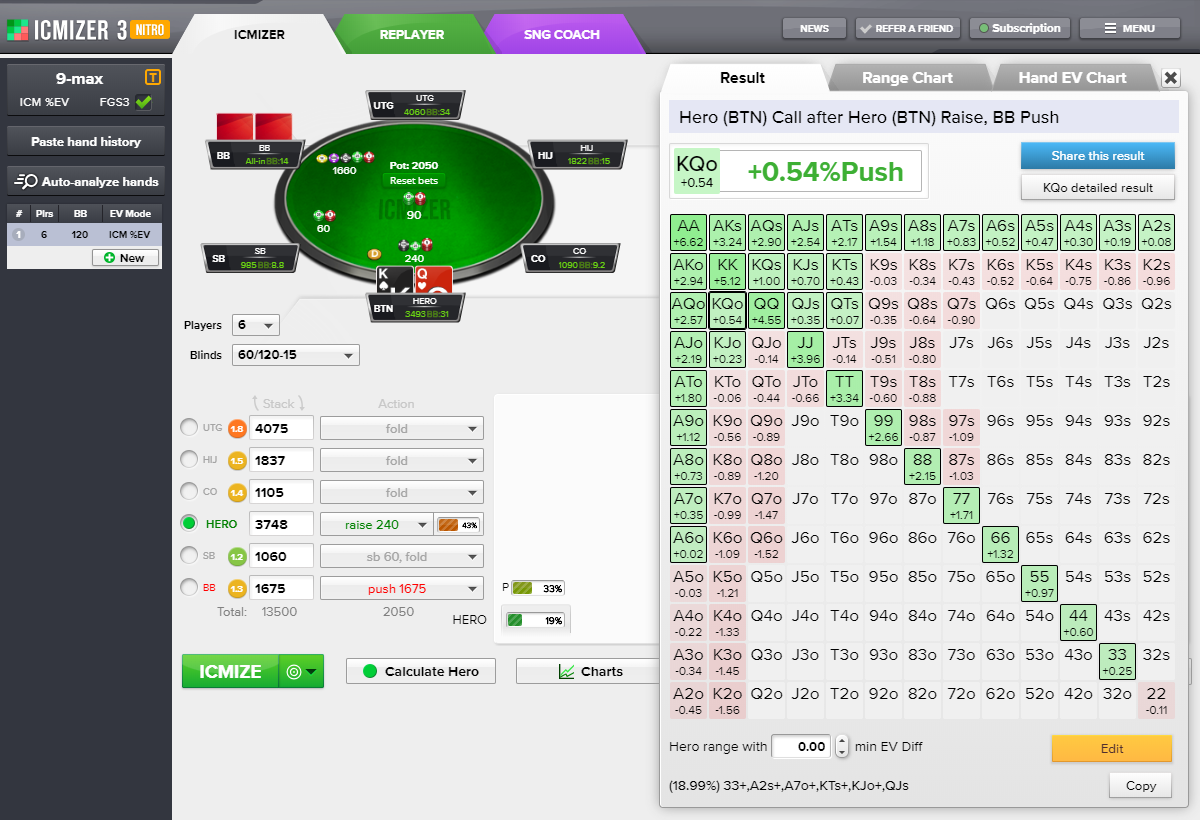
We see that Hero's optimal calling range ❶ against the pushing player on BB calculated as 19%, and his profit with KQo ❸ against BB's 33% pushing range ❷ is +0.54% of the prize pool.
The Hero's optimal opening raising range ❹ calculated as 43%.
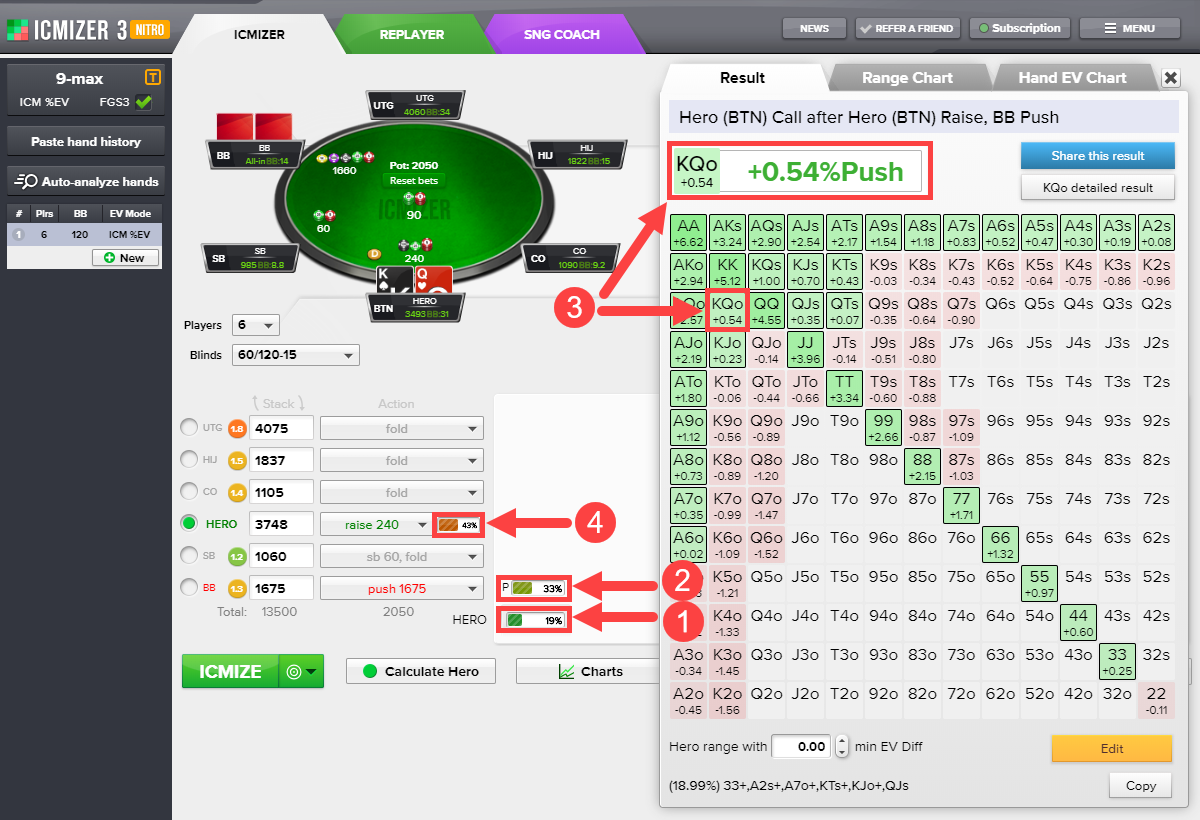
The values in the pushfold table represent the difference between the EvPush and the EvFold. The ICMIZER calculation is conclusive and includes the blinds set by the players and [the card removal effect] (https://www.icmpoker.com/en/blog/card-removal-effect-and-how-icmizer-3-handles-it/). You do not need to think up anything else, ICMIZER has already done everything and provided the final result.
If you chose the ICM $EV mode, results are displayed in dollars, ICM %EV – as a percentage of the tournament prize pool, Chip EV – in chips, Chip BB EV – in big blinds.
To see the details of calculating for KQo, click on the "KQo detailed result" button. The detailed result window presents all calculation details.
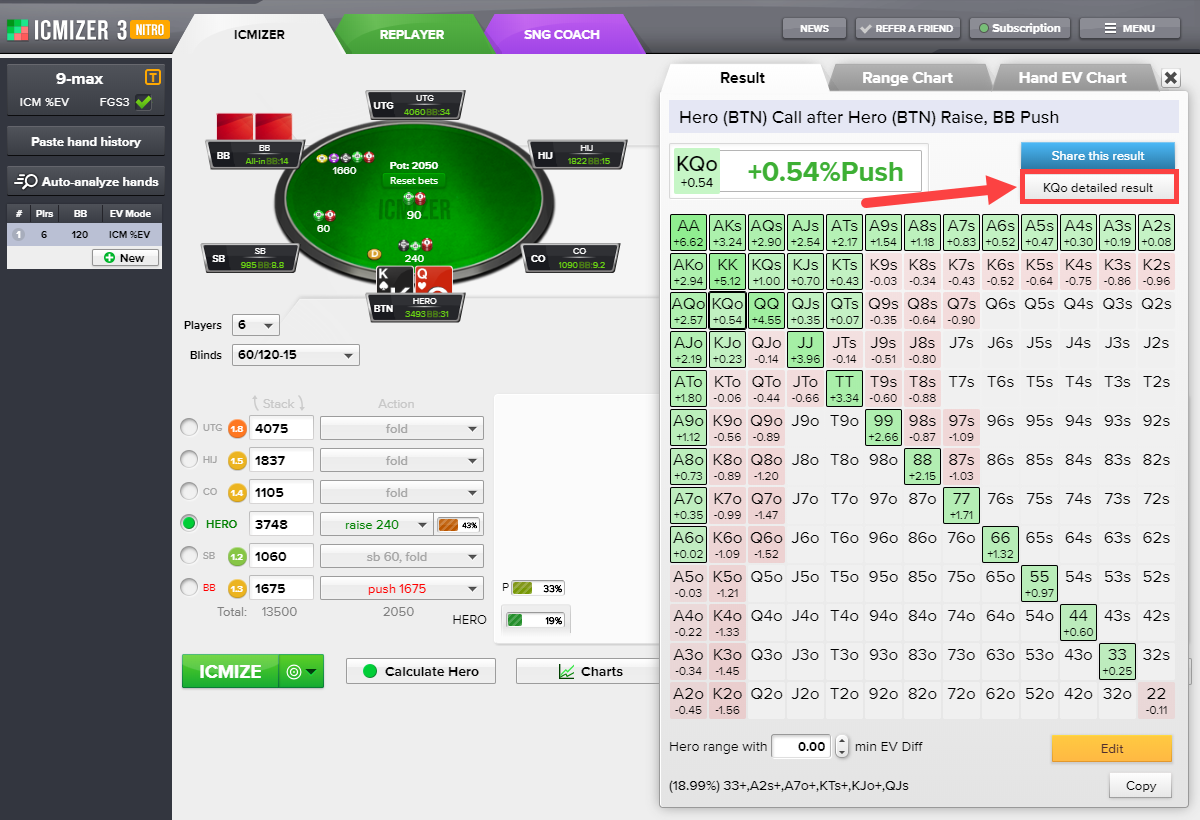
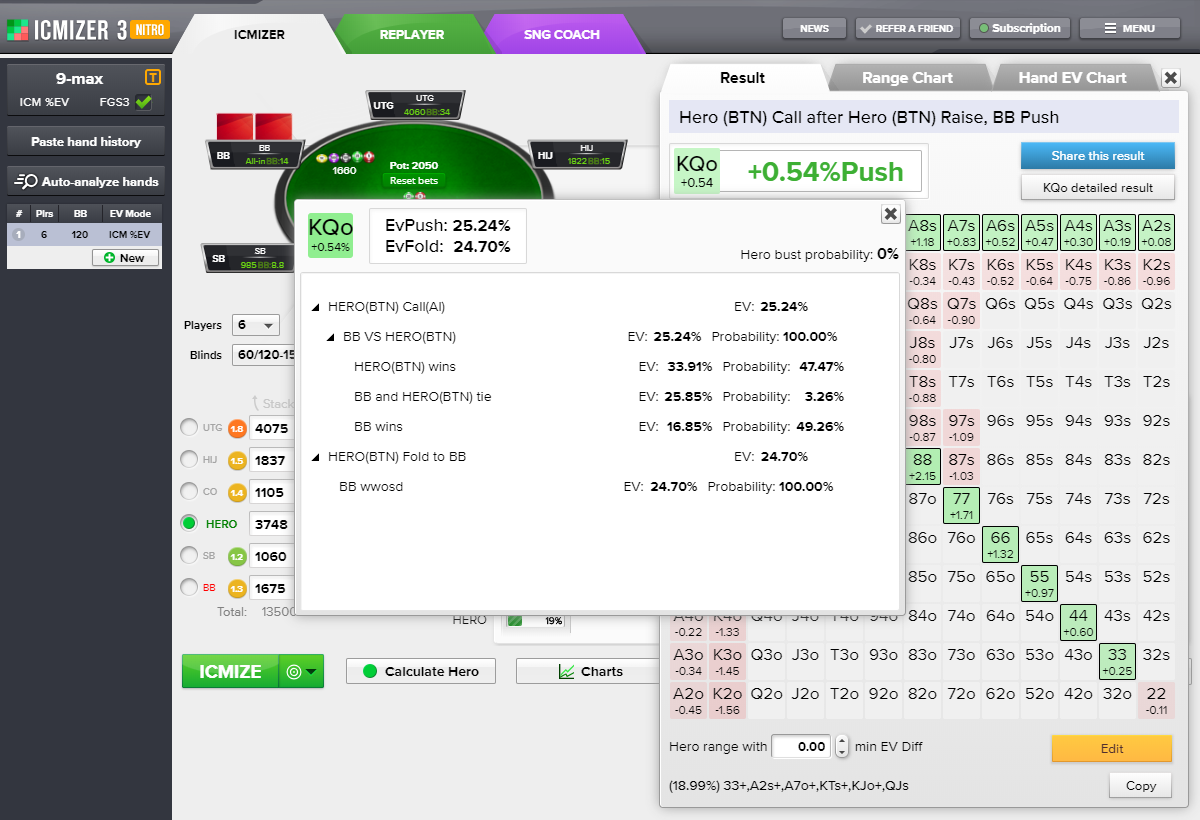
In the detailed result window we can see:
❶ EvPush (25.24%) is the Hero’s all-in equity displayed as a percentage of the tournament total prize pool. In our case, ICMIZER analyzed three possible outcomes: the Hero wins (HERO (BTN) wins), the player on BB wins (BB wins), and a tie (BB and HERO (BTN) tie). ICMIZER also calculated the probability of each outcome (Probability).
❷ EvFold (24.70%) is the Hero’s fold equity displayed as a percentage of the tournament total prize pool. In this case, the EvFold calculation is simple – BB takes the pot.
❸ The Hero's profit of call with KQo. The value "+ 0.54%" is calculated by the formula (EvPush – EvFold). Green coloring means that pushing this hand is more profitable than folding because EvPush is more than EvFold.
❹ Hero bust probability if he goes all-in. Since the Hero's stack is larger than the BB's stack, the probability of his bust is 0%.
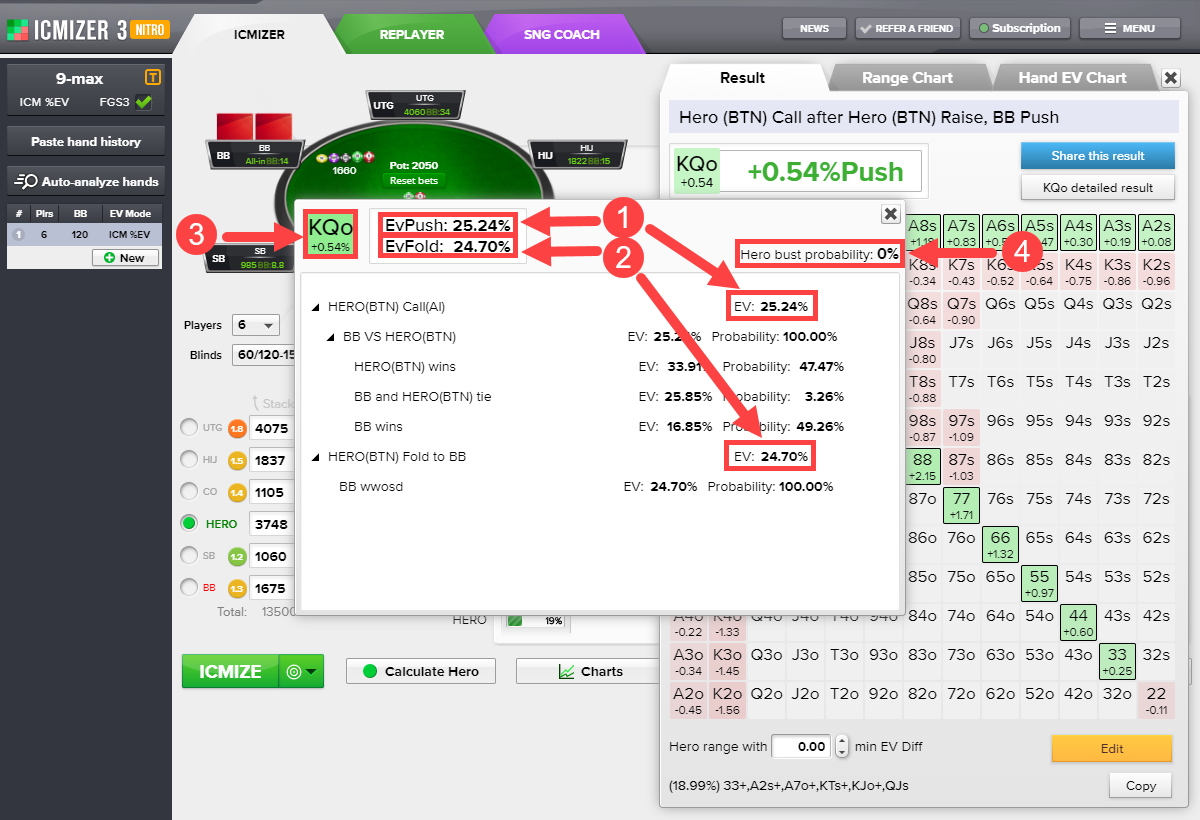
At this point, we can also build charts for opponents' ranges.
Click the ❶ Hand EV Chart tab or press the ❷ Charts button which will help us to see how wide should the player on the BB position be pushing to make the call profitable for us.
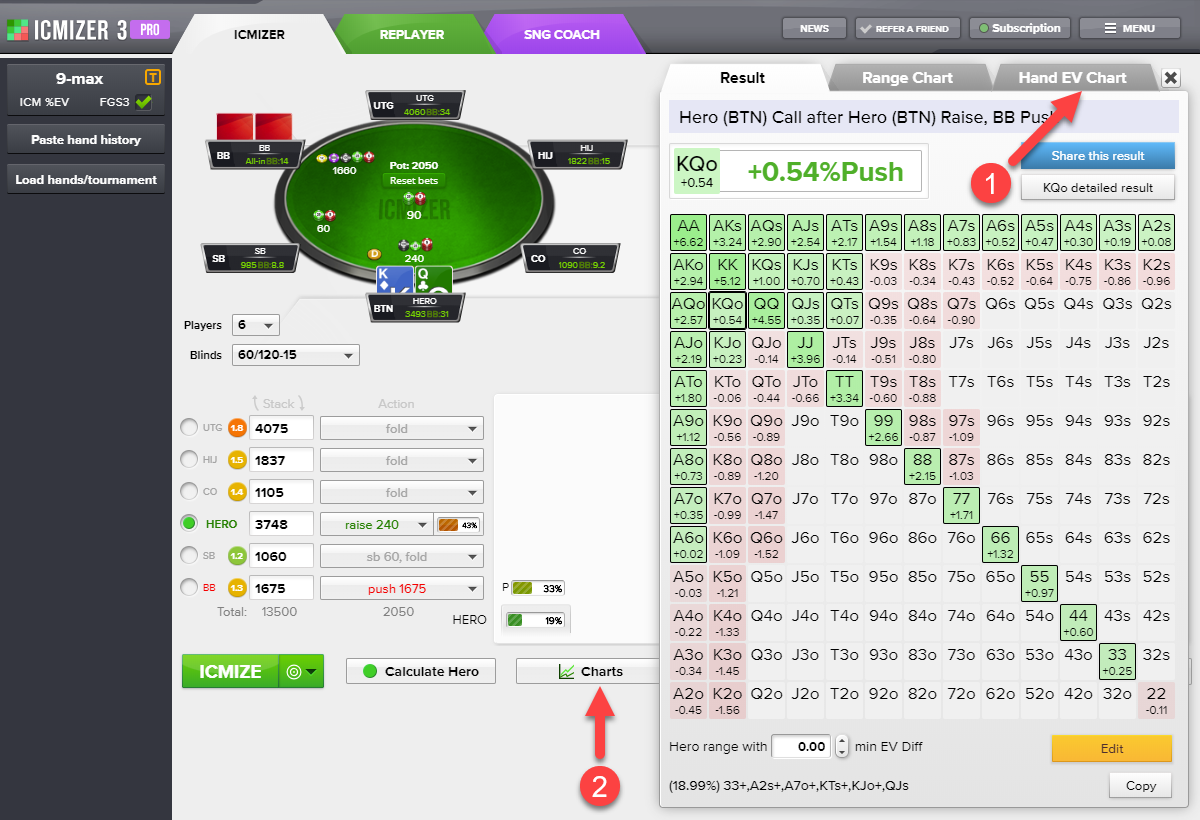
We see the following chart, which demonstrates how the profitability of call with our KQo changes depending on our opponent's range.
If we click on a point on the chart we can see the detailed information.
We can see ❶ that if BB is pushing wider than ❸ around 30% of hands we can call him profitably. In general, on the lower stakes players aren't shoving this aggressively so we probably have to muck our hands to the push.
If we wish to see how we should have played with some other hand, say AJo, we can click on ❷ its representation below the table and choose it from the popup hand selector tool.
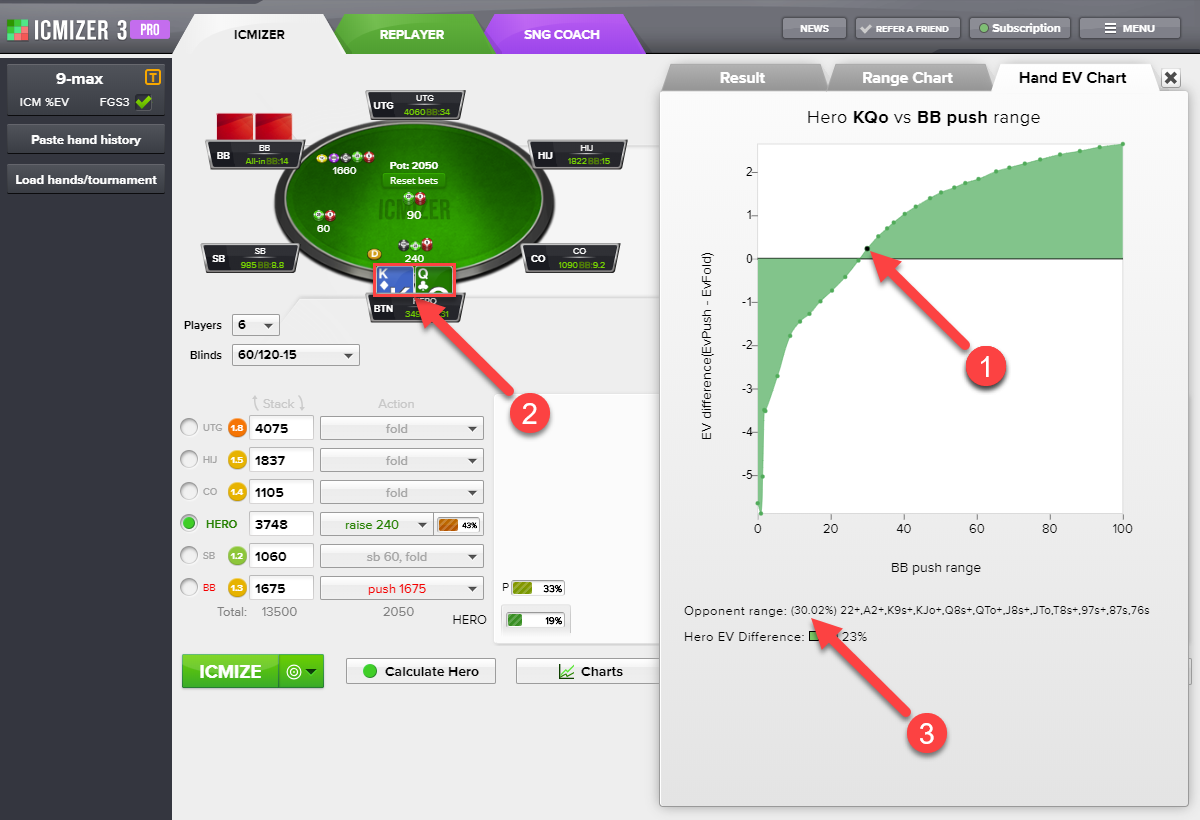
After changing Hero's hand, click again the Charts button.
AJo is a stronger hand, so the ❶ chart looks differently. We need to fold only when our opponent is pushing as tight as 14% ❷ of the best hands. They most likely are wider than that, so we can call with AJo.
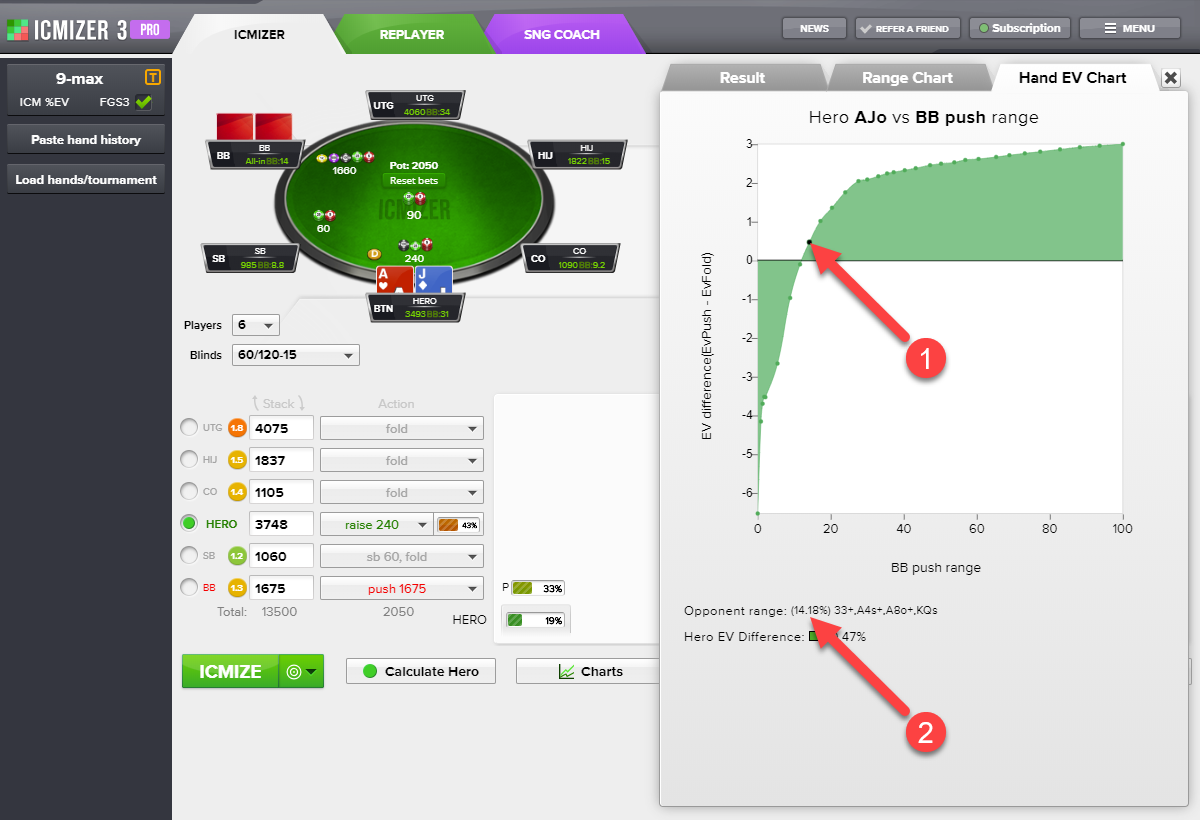
Hand #2: How to call against BTN push 3-handed with a short stack
Classic 9-max Sit'n'Go, 50/30/20 payouts
300/600-50 blinds, 3 players
BTN: 4,820
Hero (SB): 2,530
BB: 6,150
Preflop: Hero is SB with KQs
BTN raises to 4,820 and is all-in, Hero ?
Set up this hand in ICMIZER (step 1) as we've explained in the previous section. At this hand history, FGS depth needs to be set to 5 because it's a recommended value for 3 players.
Let's focus on getting and interpreting the results now.
First, click ❶ ICMIZE to find the optimal calling range for Hero on the SB against the BTN optimal push and to see how the optimal strategy versus opponents who play optimally looks like.
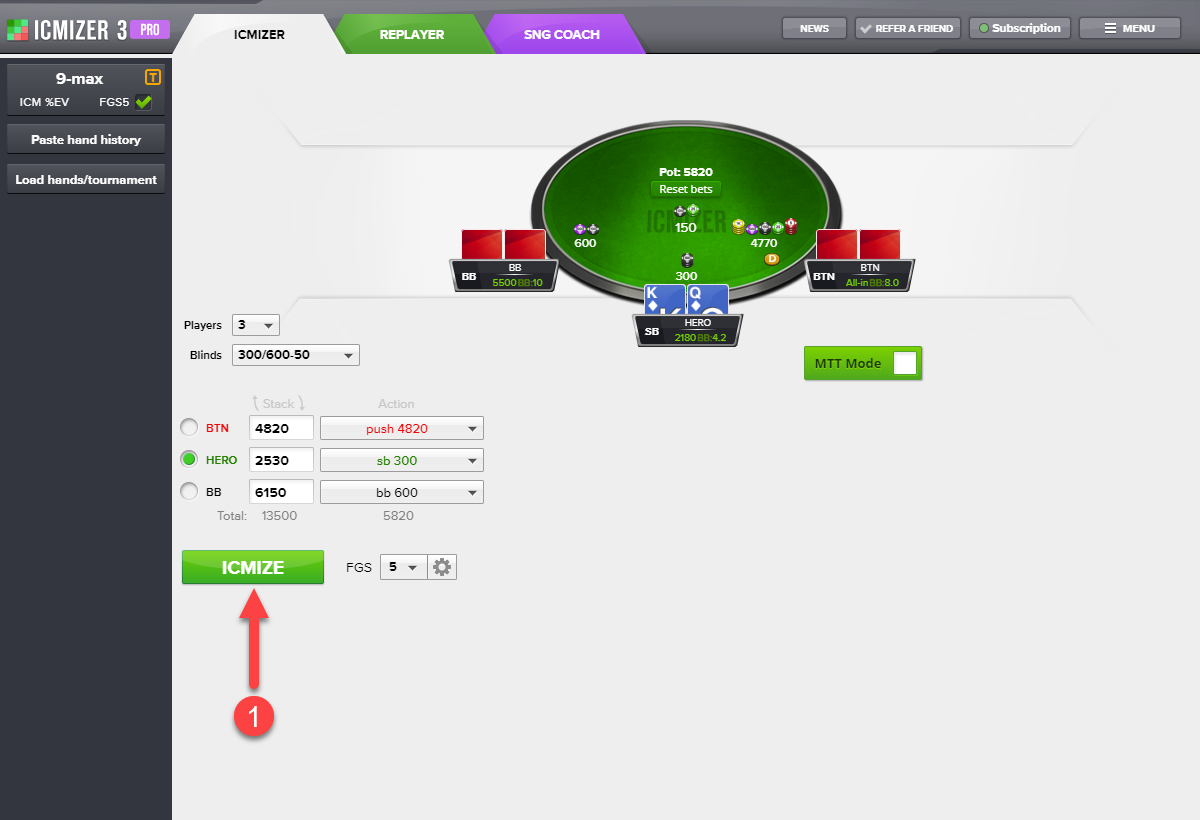
We can see that we can call with 55+,A5s+,A8o+,KTs+,KJo+,QJs range.
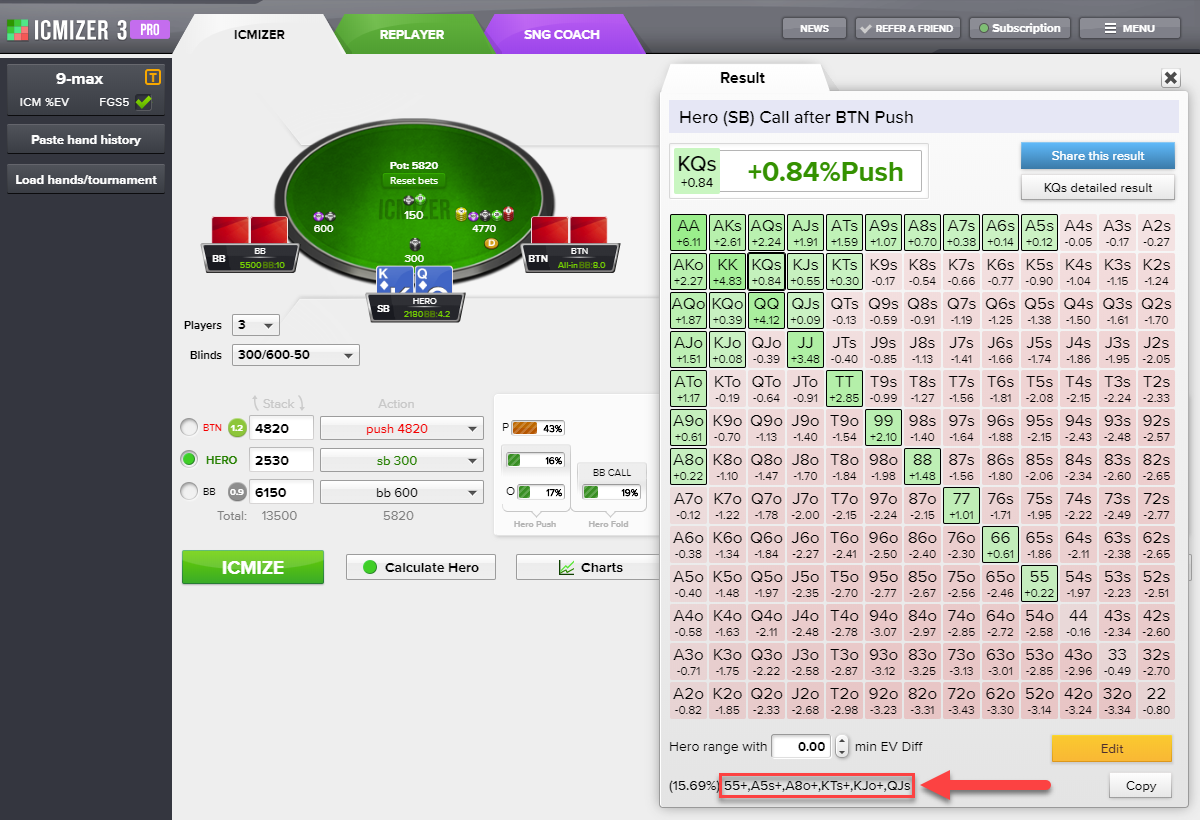
The key factor which affects our decision here is the ❶ BTN push range.
Let's use the Hand EV Chart to see how tight our opponent on the button has to be for KQs to become a fold. For that click the ❶ Charts button and then click on ❷ BTN push range to build a chart.
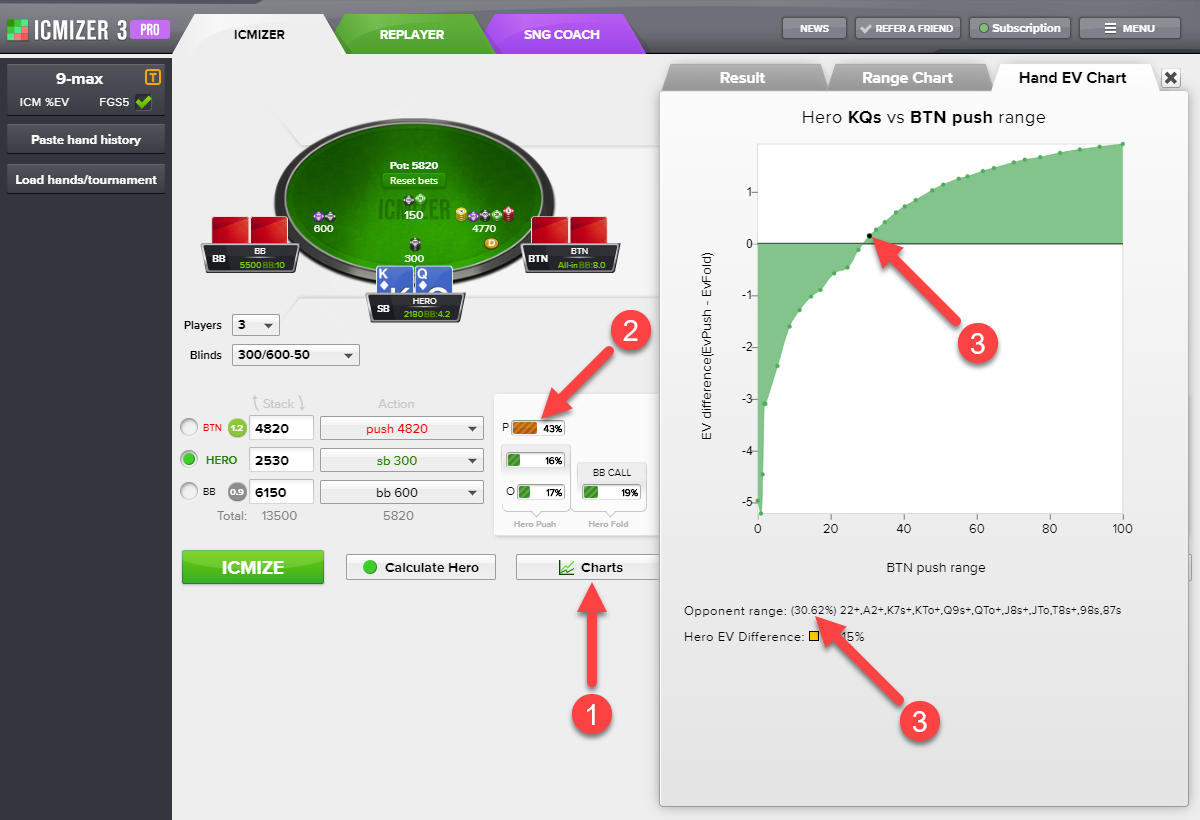
So if we assume that BTN is pushing lower than ❸ around 30% of hands in this spot we should be folding KQs. But that's only is applicable if BB ranges are the same (17% for BB Overcall and 19% for BB Call).
Hand #3: How to defend versus SB raise 3-handed from the Big Blind position
Classic 9-max Sit'n'Go, 50/30/20 payouts
100/200-25 blinds, 3 players
BTN: 7,240
SB: 2,945
Hero (BB): 3,315
Preflop: Hero is BB with A2o
BTN folds, SB raises to 400, Hero ?
Set up this hand in ICMIZER (step 1) as we've explained in the previous section. As at previous example at this hand history, FGS depth needs to be set to 5 also because it's a recommended value for 3 players.
Let's focus on getting and interpreting the results now.
First, click ❶ ICMIZE to find the optimal calling range for Hero on the BB against the SB optimal raise and to see how the optimal strategy versus an opponent who plays optimally looks like.
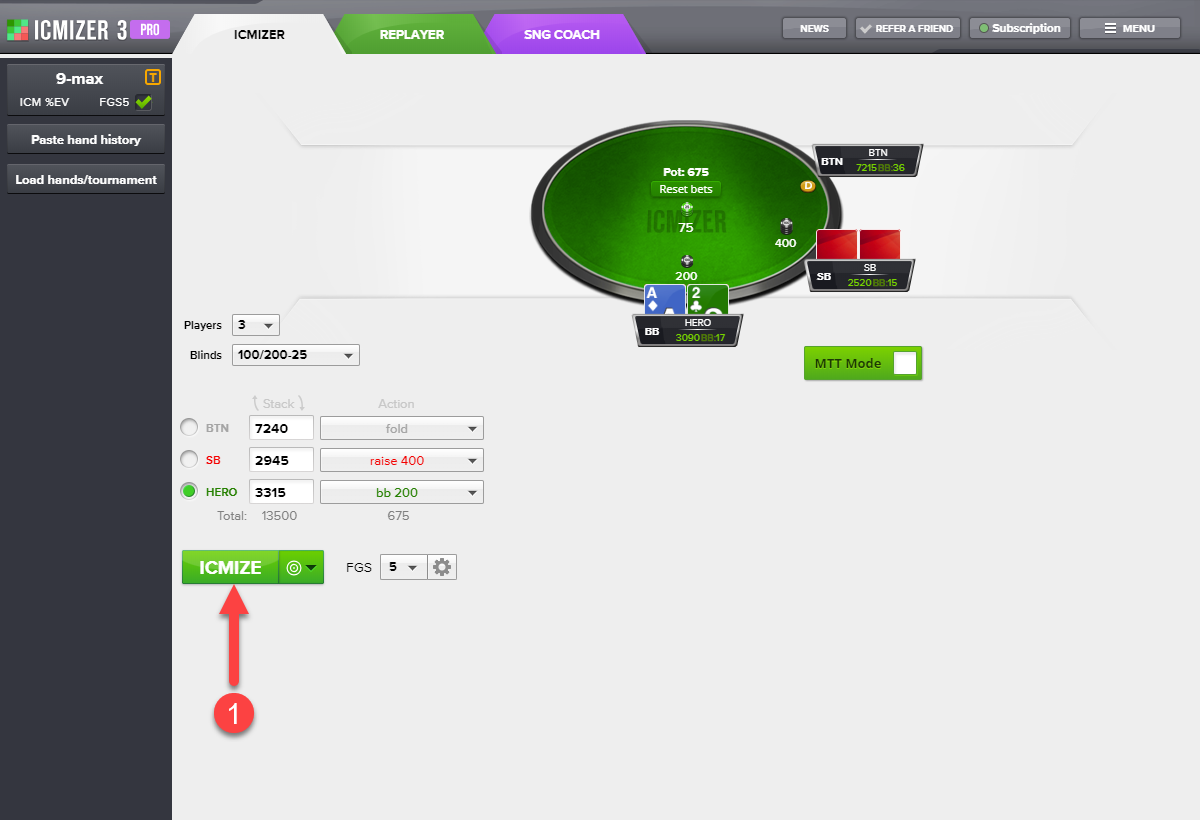
We see that Hero's optimal push range calculated as 54% and our profit with A2o push is 0.73% of the prize pool.
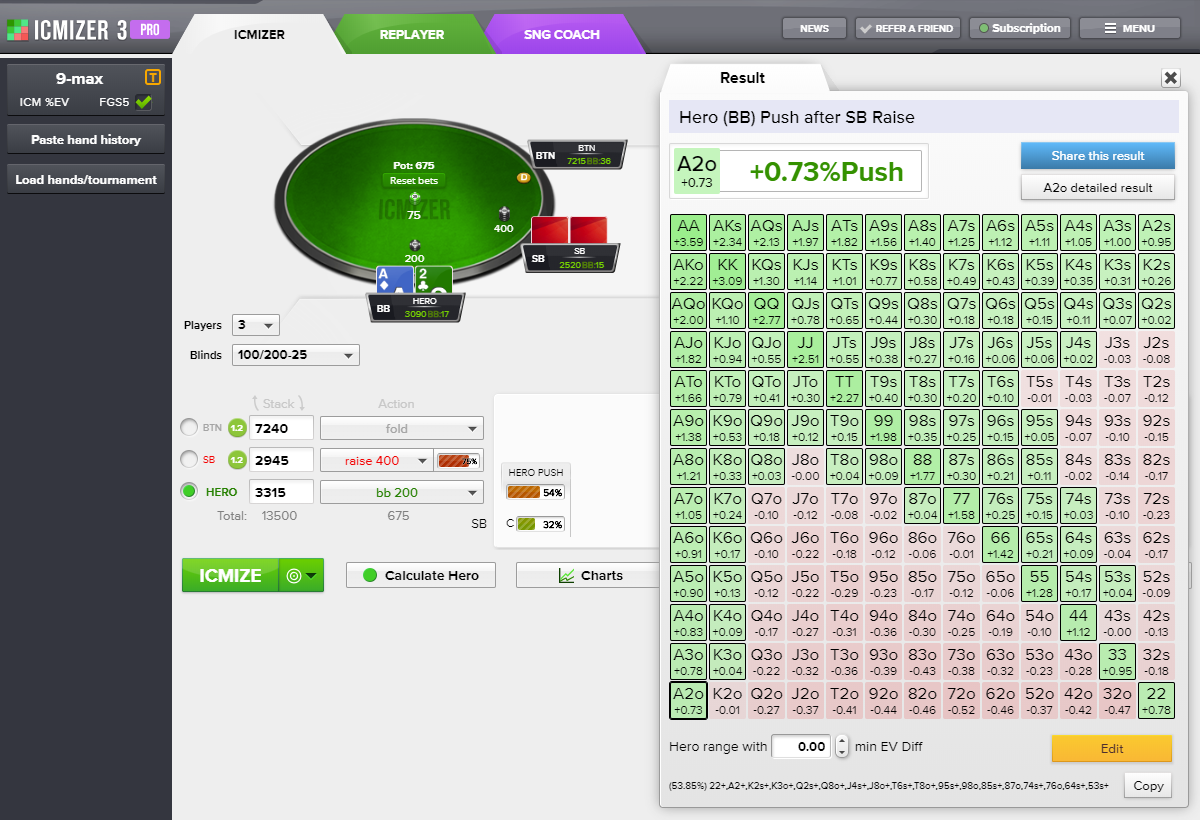
Let's have a look at how our hand looks like against several potential SB calling ranges by Hand EV Chart. For that click the ❶ Charts button and then click on ❷ SB call range to build a chart.
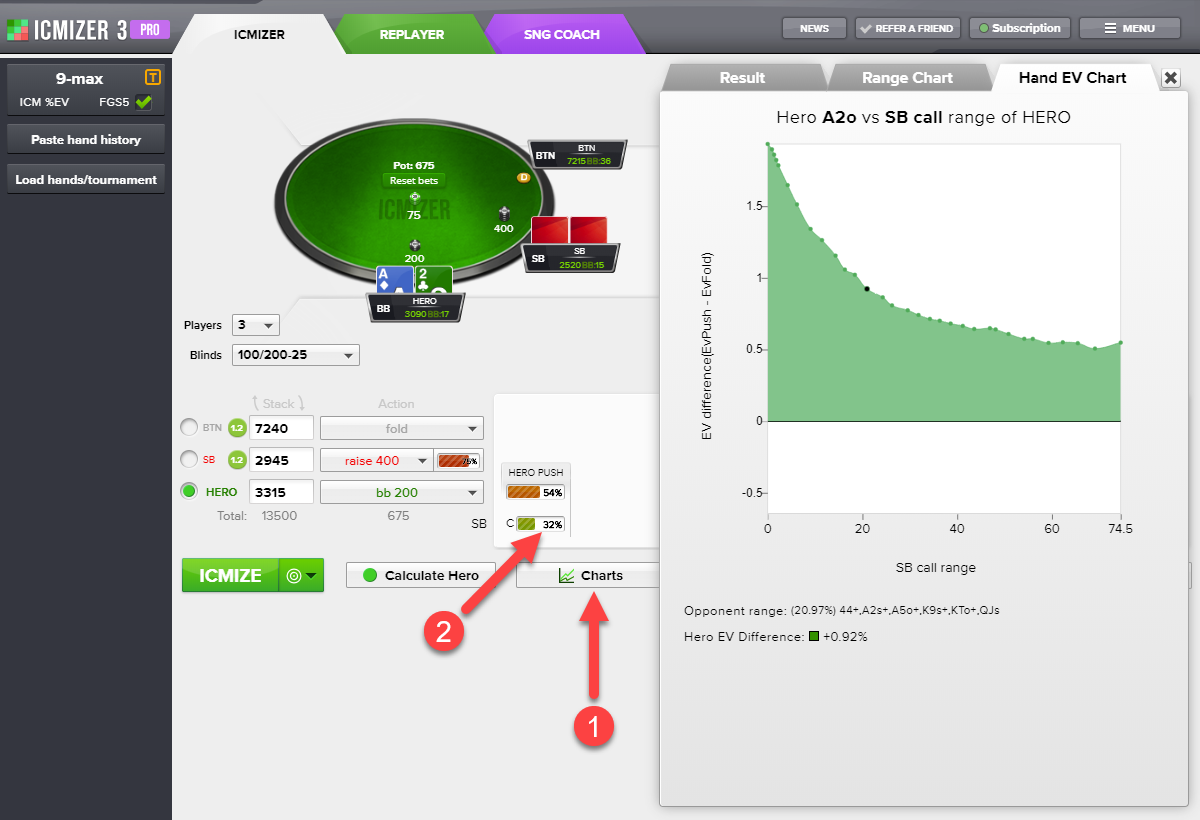
As we see all SB call ranges are profitable for us and the more tight SB call range is the - more profitable Hero's hand is.
Let's look how Hand EV Chart looks with Hero Q2s in hand.
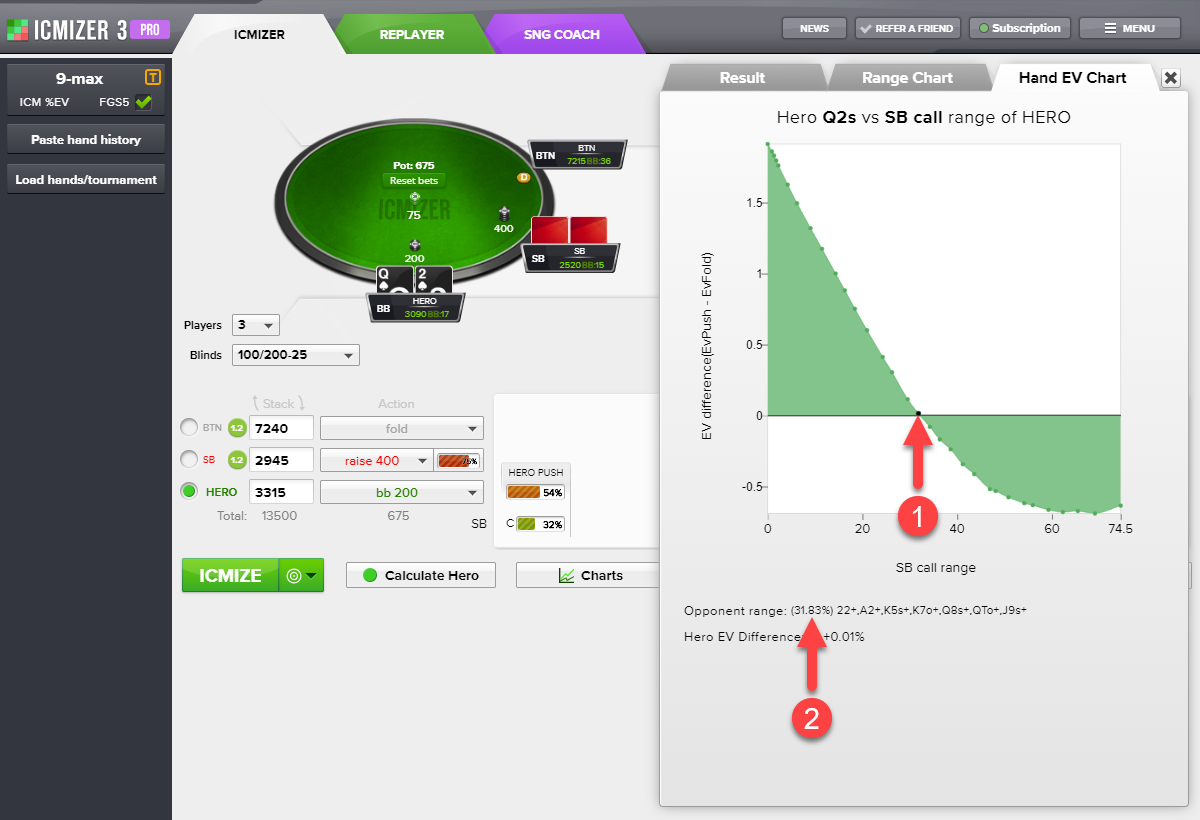
With Q2s we got quite different chart with ❶ profitable prediction starting at around ❷ 32% of SB call range value.
Conclusion
In this article, we've learned how to set up hands in ICMIZER and how to find optimal decisions based on the ranges of our opponents in a basic way.
Remember, almost no one is playing according to Nash equilibrium. On the lower stakes, players deviate from the Nash ranges, that is they call tighter or they push wider than the Nash equilibrium recommends in some cases or tighter than the Nash equilibrium recommends in the other cases.